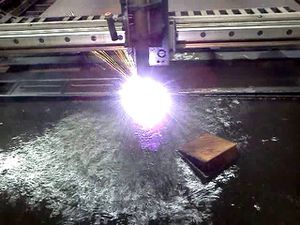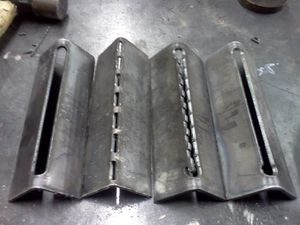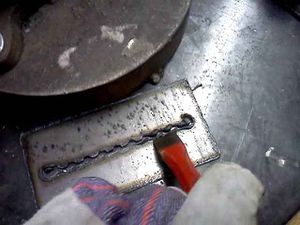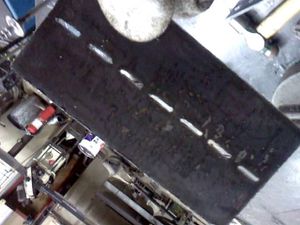TorchTableTraining
Chuck Harrison Torch Table Training
I signed up for a class offered local to me (Seattle) by Rusty Oliver. First session 27-Nov-2012.
Rusty has a 5x10 ft Torchmate table with a Hypertherm PowerMax 1000 plasma cutter good for about 60 amps. It cuts 3/8-in comfortably and struggles with 1/2-in steel.
Notes:
- Plasma cutting takes a lot of compressed air, count on a 3-5 hp compressor with a 60 gal tank.
- Moist air cuts down lifetime of the consumables (torch electrode parts) dramatically. Use filter-driers.
- Torch height is critical to good cut quality. 1/8-1/4 inch is typical.
- Rusty has a Torchmate automatic height control Z axis but it has not been very effective. Tends to hunt up and down
- Z axis is a servo (not stepper), which means it can sense stall via motor current
- To find part surface prior to striking arc, Z axis drives torch down until it hits part, then backs up
- During cutting, Z axis is controlled to maintain a desired arc voltage
- Different standoff heights are used for piercing and subsequent cutting.
- Automatic height control is a separate module (not part of the PC-based software) with several programmable parameters
- Torchmate software provides basic 2D drawing capability, tool path generation (kerf allowance), import DXF, svg. Generates and executes G code. Many features I have not learned about yet. Tutorial from Yale, MIT.
- Cut quality is worse than I expected. Lots of dross and several degrees bevel in ~3/16-inch thick steel. From manufacturer videos I think it can be done better.
- There are problems with torch cutting bolt holes. Piercing is hard on the torch (wears out consumables). The hole is tapered, may not be perfectly round, and can't be easily drilled out because of the hardened heat-affected-zone left by the torch. Not impossible, just not easy.
Fold patterns
My first parts. Using 11ga (0.120" thick) mild steel sheet, cut four 3x6 inch coupons with fold features. Three patterns with relatively wide slots were prepared in inkscape and a fourth simple "dotted line" pattern was prepared at the machine (no file kept).
All cuts at 50amps, 80psi, 13.5ipm on Hypertherm 1000. Cut time for each sample fold part (including both perforation and outline) a bit under 2 minutes. Kerf width was about 0.10in, torch standoff ~1/8" (not really sure how accurately so) based on z-axis touch-off but without arc voltage height control. Edges were pretty square, much less bevel than I had seen in earlier cuts. Rusty felt cut speed was quite conservative and we could have moved faster.
The dotted-line fold worked quite well. This sample was about 70% perforated with 1/4-inch webs remaining. This fold line could be subsequently welded if desired. The other folds had much too wide a gap for that.
The plasma cut left quite a bit of dross/slag. It was easy (if time-consuming) to remove it with a hammer (at the outside edges) or a chisel. By the "feel" of a hand file, there is a harder layer at the cut edge (heat affected zone) but it's only 0.010 or .020 in thick. If it's necessary to clean up the edges a grinder or sandpaper is probably preferable to a file. ChuckH 08:11, 12 December 2012 (CET)
CAD toolchain
I have produced several .svg test files using extopenSCAD. I haven't worked out the kinks in importing these to the Torchmate environment. Best so far is to open the svg file in inkscape, save as eps (encapsulated postscript). Torchmate CAD will import the eps file (it offers two input filters for the eps file, "eps" and "pdf", both seem to work). Exporting immediately from Torchmate CAD to dxf, then using the Torchmate driver to generate gcode and run the table gives basic function, with the toolpath on the geometry line. Using the toolpath generation tools in Torchmate CAD resulted in duplicated cutting paths on different dxf layers (haven't yet figured out how to do this right).
Noticed that the gcode does not include any special codes at the start/end of a cut; the command lines are just G0's (move without cut) and G1's(cut).




